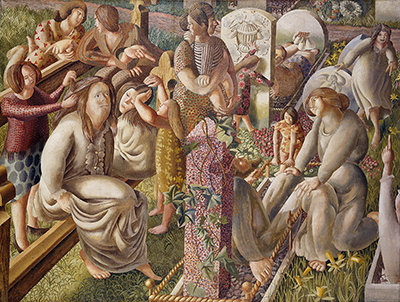The Resurrection is an oil on canvas, 76.2 cm by 101.6 cm religious painting, which was among a series of paintings of resurrections, done in 1945.
The whole idea of resurrection really intrigued Spencer. All the resurrection paints came after his post-war experience and the release from his military service as symbolic to been born again, hence the many paintings of resurrections. He painted this theme on many occasions. In his paintings, the idea that God is found everywhere is especially profound in his birthplace of Cookham on the Thames. Spencer had greatly adored Italian painters and from Botticelli, he mastered how the biblical how to transplant biblical scenes to present day, and the art of telling how a story unfolds over time. The narrative composition of the resurrections in the painting can be traced back to the influence of Giotto and Fra Angelico and in the complex layers of characterful figures. The paint also gives a tapestry feel through the intertwining of figures with the foliage and the gravestones found in the painting.
The main theme for this painting, The Resurrection, Tidying, was to express the notion of different kinds of appearances and emotion. All these emotions are seen in the faces of the different subjects in the painting. The subjects are seen experiencing rebirth through the experience of human relationships. Most of the figures are calm and relaxed, with young children brushing their mother's hair and embracing them. These figures could be all the children who perished in the war that Spencer experienced during his service in a medical camp. All the faces reflect innocence. His first painting inspirations were from a local painter, where he together with Gilbert took drawing lessons from. This was further compounded when his father made him take classes with Lady Boston, a painter herself. His legacy lives in the originality in merging of the narrative literal with visions and imagination.
During the first world war, he was given copies of Saint Augustine Confessions where he adopted the idea that God is glorified by the most trivial of actions. As a result, in one work, dustbin men become lovers, and others carrying leaders mimic Christ burdened by the crucifix. Other paintings by Spencer include Soldiers Washing of 1927, Portrait of Patricia Preece of 1933, Love letters of 1950, and Gardens In The Pound, Cookham of 1936.




